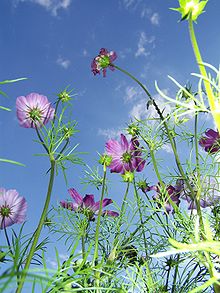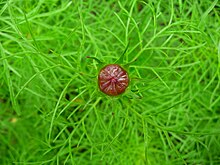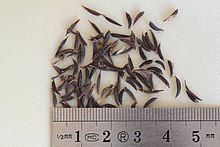Jewelry baskets
| Jewelry baskets | ||||||||||||
|---|---|---|---|---|---|---|---|---|---|---|---|---|

Inflorescence of a cultivar of Cosmos bipinnatus with honey bee |
||||||||||||
| Systematics | ||||||||||||
|
||||||||||||
| Scientific name | ||||||||||||
| Cosmos bipinnatus | ||||||||||||
| Cav. |
The Cosmos ( Garden Cosmos , Syn. : Cosmea bipinnata , Bidens formosa . (Bonato) Sch.Bip , Coreopsis formosa Bonato ), also Fiederblättrige Schmuckblume called or Kosmee, is a plant of the genus Kosmeen ( Cosmos ) in the family of Compositae (Asteraceae ). It is best known for its use as an annual ornamental plant . Some varieties are also suitable as cut flowers .
description
Vegetative characteristics
Cosmos bipinnatus are annual herbaceous plants that reach heights of growth of up to 2 m. The branched stem is usually densely or occasionally covered with fine, rough trichomes that split upwards , some specimens are also completely hairless. The foliage leaves , including the petiole, are usually 5 to 15 cm long and are divided into two to three pinnate columns. The petiole itself is inconspicuous, winged, 10 (rarely up to 15) mm long, sometimes the leaves are almost sessile. The partial leaves are linear-thread-shaped to narrowly linear with a width of 0.5 to 1 (rarely up to 1.7) mm; the tips are pointed, hardened, but not particularly sharp.
Inflorescences and flowers
The very conspicuous cup-shaped inflorescences usually have a diameter of 5 to 7 (rarely 8) cm and contain ray and tubular flowers, which are surrounded by bracts. The outer bracts are usually eight and are ovate to lanceolate-tail-like in shape, 7 to 15 mm long, 3 to 5 (rarely 6) mm wide. The inner bracts are ovate-lanceolate and 8 to 12 mm long. They are translucent with many black stripes and a clear edge up to 1 mm wide, which sometimes has yellowish or pink pigments, the tip is ciliate. The chaff leaves have golden-yellow, thread-like tips and protrude between the tubular flowers. The broadened base of these chaff leaves is translucent with a yellow line.
The mostly eight ray-florets are pink to violet or white in color, at the base there may be conspicuous spots colored by anthocyanins . The tongues are inverted egg-shaped, have a length of usually 20 to 35 (16 to 40) mm and a width of usually 12 to 20 (8 to 25) mm. The tips are almost blunt and have three broad, wavy teeth. Below that they are greatly rejuvenated.
In the center of the flower head there is a large number of tubular flowers (also called disc flowers), the overgrown petals of which are yellow, turn white in the lower area and reach a length of 5 to 6 mm. The anthers are brownish-black and about 3 mm long, at the tips are short-triangular, translucent appendages with a length of 0.5 to 0.8 mm. The ramifications of the stylus are short and rather blunt, with a length of 0.5 mm.
fruit
The achenes are blackish, smooth or short-bristled. Their shape is linear-spindle-like, the length of the outer achenes is 5 to 8 mm. They are rounded to a short, 0.5 to 1.7 mm long, but clearly pronounced rostrum . The inner achenes are up to 18 mm long, their yellowish beaks are 4 to 5 (rarely up to 10) mm long. A pappus is missing or it only consists of two to three awn-like, 1 to 3 mm large bristles.
Chromosome number
The number of chromosomes is 2n = 24.
distribution
Cosmos bipinnatus is native to the area from Arizona in the USA via Mexico and Guatemala to Costa Rica . Since it is used as an ornamental plant in many countries and has a tendency to feral, it is an invasive plant in many areas of the world .
swell
- Robert W. Kiger: Cosmos. In: Flora of North America. Volume 21, p. 204: Cosmos bipinnatus - Online.
Individual evidence
- ^ A b Cosmos bipinnatus in the Germplasm Resources Information Network (GRIN), USDA , ARS , National Genetic Resources Program. National Germplasm Resources Laboratory, Beltsville, Maryland.
- ↑ a b c Thomas E. Melchert Cosmos bipinnatus. In: Dorothy L. Nash, Louis O. Williams (Eds.): Flora of Guatemala. In: Fieldiana: Botany. Volume 24, Part XII, 1976, pp. 230-231.
- ↑ a b c Description in the Flora of North America. (engl.)
- ^ Erich Oberdorfer : Plant-sociological excursion flora for Germany and neighboring areas . With the collaboration of Angelika Schwabe and Theo Müller. 8th, heavily revised and expanded edition. Eugen Ulmer, Stuttgart (Hohenheim) 2001, ISBN 3-8001-3131-5 , pp. 929 .
Web links
- Thomas Meyer: Decorative basket data sheet with identification key and photos at Flora-de: Flora von Deutschland (old name of the website: Flowers in Swabia )
- Profile ( Memento from December 13, 2004 in the Internet Archive )




